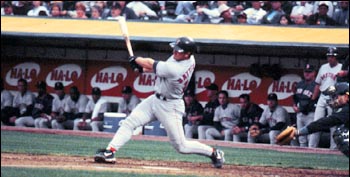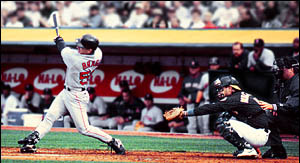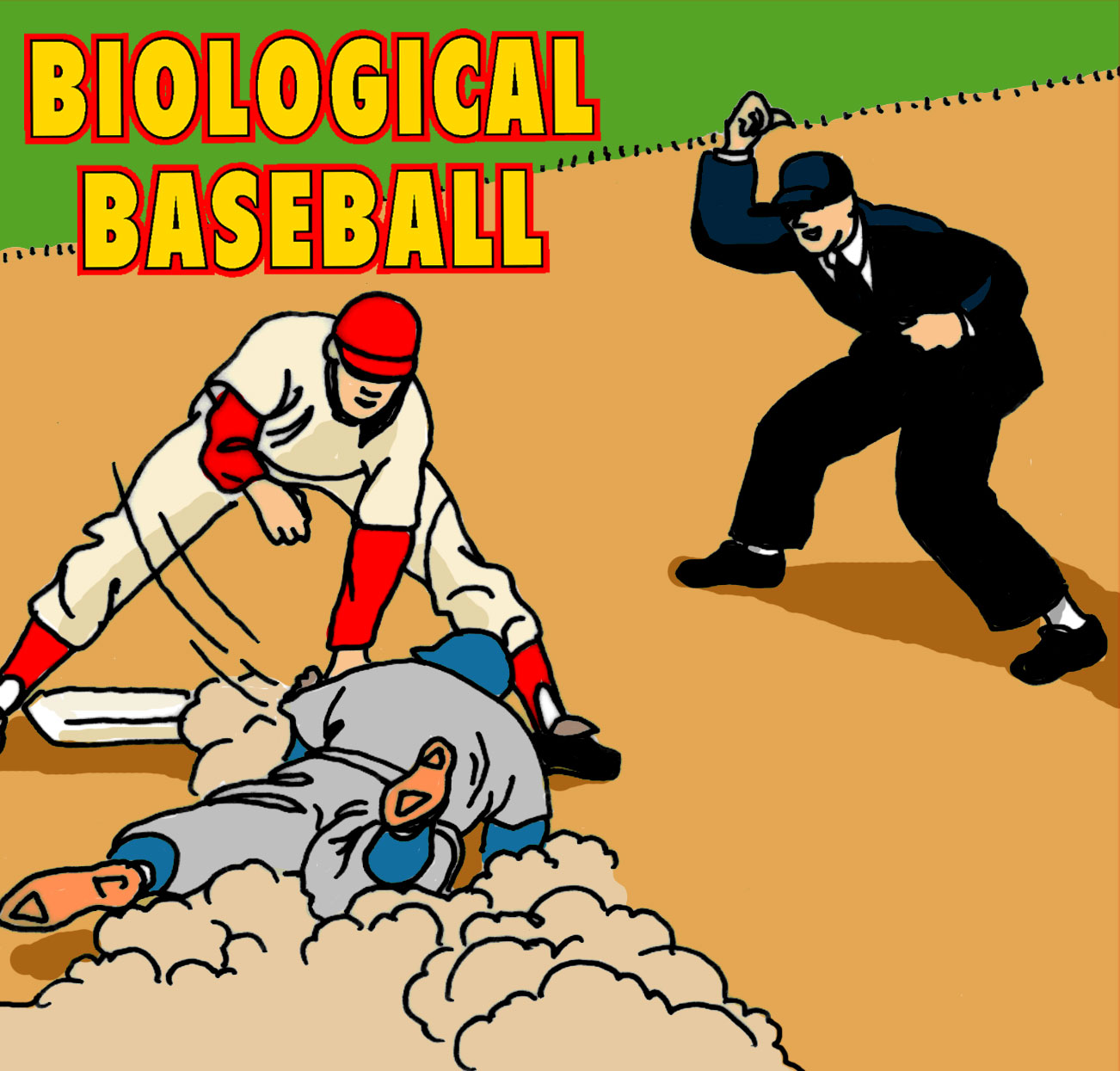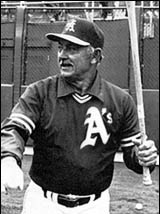Biological Baseball
A major league pitcher can throw a baseball up to 95 miles per hour -- some can move it even faster. At this speed, it takes about four tenths of a second for the ball to travel the 60 feet, 6 inches from the pitcher's mound to home plate, where the batter, with muscles as tense as coiled springs, like a predatory animal about to pounce, waits for the precise moment to swing at the ball. Baseball is a game played at the edge of biological time, just within the limits of a human's ability to react.
Charlie Metro: "It's a very difficult thing to do, to hit a moving ball at 95 miles an hour in one-tenth of a second!"
By the time the ball has traveled a dozen feet from the pitcher's mound, the batter has a good visual fix on it. In a thought process much too quick for deliberation, he has decided whether the pitch is a fastball, curveball, slider, knuckleball, screwball, or whatever -- yet a good deal of data has gone into this instantaneous and non-verbal decision.
Charlie Metro: "The good hitters get their tip-off from the pitchers. And there are many, many ways that a pitcher tips off his pitches. He grips it like that [fingers straight over top of ball]; there's your fastball. When he throws a curveball, he chokes the ball [wedges it between his thumb and forefinger, gripping it on the side so it sticks out]. Now see how much white of the ball shows on a fastball? And how much more white shows on a curveball? . . . Another thing is when they bring the ball into the glove, when they come in with a flat wrist like that, that'll be a fastball. When they turn their wrist like that, it's a breaking pitch. There are many, many ways, and the good hitters pick out these things . . . facial expressions . . . human habits and characteristics will tell."
During the entire middle portion of the pitch, the batter must time the ball and decide where to swing. If the batter decides to swing, he must start when the ball is approximately 25 to 30 feet in front of the plate. The ball will arrive at the plate about 250 thousandths of a second later -- about the limit of human reaction time. The bat must make contact with the ball within an even smaller time range: A few thousandths of a second error in timing will result in a foul ball. Position is important, too. Hitting the ball only a few millimeters too high or too low results in a fly ball or a grounder.
Exactly how humans are able to estimate the expected position of a quickly moving ball is unknown. Obviously, this remarkable skill is learned through long practice. Eye-brain-body coordination is acquired only by going through the motions over and over; even so, the batter misses most of the time. Getting a hit three times out of ten at bat is considered an excellent average. It's interesting that George Schaller and other ethologists have observed that lions and cheetahs are also successful only about a third of the time in capturing their prey.
Just A Nerve Impulse Away
Human reaction time is ultimately limited by how fast nerve cells conduct nerve impulses. Although this speed is almost 250 miles per hour, messages still take a significant amount of time to travel from sensory organs to the brain and back to the appropriate muscle groups.
A few reactions are fast because they skip the brain altogether--the knee-jerk reflex, for example, requiring only a few nerve-cell-to-nerve-cell interconnections, and thus happens in "the blink of an eye." The neural pathway makes a short loop from sensory cells through interneurons to motor nerve cells, which control the appropriate muscle groups. A message is sent to the brain at the same time it is sent to the muscles, so we actually become aware of the knee jerk as it happens.
Unfortunately for the batter, swinging the bat requires more than a simple reflex pathway. Judgment, decision-making, and total body movement add up to hundreds of thousands of nerve cells working simultaneously. And conduction velocity along the nerve fiber isn't the only factor affecting reaction time.
When one nerve cell signals another, it does so by releasing a chemical substance which crosses a tiny gap between the cells, called the synapse . It takes about half a thousandth of a second for the chemical transmitter to flow across the gap, a period called synaptic delay .
The longest delays probably involve the nerve cells that make the decision to swing. These decision-making cells receive their input from the eye by way of the brain's visual cortex. It takes at least 43 thousandths of a second for information about the velocity and trajectory of the baseball to be sent from the retina to the higher visual cortex. What happens during the actual "decision" is a neurological mystery — but once the decision is made, a signal is sent to the cerebellum initiating a series of pre-programmed, reflex-like actions (for a practiced batter).

Batters, like pitchers, transfer body momentum into bat speed by sequential summation of movement: hips and legs turn first, then torso, shoulders, arms, and finally wrists, creating a powerful whip action.
The last fraction of the ball's flight across the plate is consumed by commands to the bat-swinging muscles. Amazingly, even after the batter has started his swing, he still has some ability to reverse his decision and check his swing.
Moving a single group of muscles may require the interaction of numerous nerve cells and involve multiple synaptic delays, as the body receives sensory information (sees the ball), processes it (makes a decision), and coordinates muscle action (swings the bat). Practice eliminates wasted time by speeding up the decision-making -- somehow the obvious mistakes and fruitless actions a novice spends time thinking about are simply ignored by the practiced player, and his brain saves the time needed to consider them. But basic reaction time due to nerve conduction and synaptic delay remains an irreducible constant of the game.
Finding The Ball
Other factors that affect the batter's swing are the effective length and weight of the bat. The farther up the handle the hitter holds the bat, the less time it takes to swing at the ball, for the simple reason that there is less mass to move through space, and therefore less inertia to overcome with sheer muscle power. But consequently, less mass hits the ball. Power is the trade-off for speed and precision, hence the maxim that the more powerful the swing, the less likely the hit.
Charlie Metro: "Singles hitters hit for average; power hitters hit home runs . . . it's like using a hatchet to cut with precision, or an axe. One is accuracy with a hatchet, and the other is power with an axe. One is a powerful thing and the other is delicate."
The age of a player affects batting success. Up to about age 35 or so, the batter is likely to keep hitting better, which suggests that good hitting requires experience with many different pitches and styles of pitching. Apparently, a hitter's judgment improves with age; finally, of course, he begins to slow down physiologically.
If the batter doesn't hit the ball just right, he's in trouble. An amazing series of reactions propels a shortstop or third baseman into the path of a hard-hit ball. In two steps or less, he may have already caught the ball and fired it to first base for an out, with a swiftness and assurance acquired only through years of practice. Inherited skill alone just won't do the job.
Watch a beginning little league team sometime — often a fielder will wait until after the ball has quit rolling before going after it, or will run to the wrong spot to make a catch.

Catchers and hitters need an instantaneous ability to predict ball trajectories.
The human ability to estimate trajectories of moving objects is difficult to explain. Good fielders begin their movement just as the ball is hit, without wasting even half a step. An outfielder instantly begins running toward the spot where he thinks the ball will fall. Sometimes, he will make a running catch without losing a stride, thrusting his glove into position at the last second.
Charlie Metro: "The great catches are made at the start, not at the end. The end is the net result of the start . . . If you pivot [correctly], you've made one step and you're three or five feet, whatever, toward the ball. . . . But if you do this [leaning the wrong way, stepping across] you've taken three steps and haven't moved out of your tracks. So the great catches in the outfield are made with the initial move."
The ability to accurately predict where the ball will be involves the extrapolative capacities of the brain, but these skills are not completely unique to humans. For example, relatively tiny-brained animals like frogs can spear flies on the wing with their sticky tongues. To do so, their brains must be programmed to determine when the flies are within range and which way they are moving. Dragonflies and birds of prey are able to dive on and capture small moving animals.
Certainly this feat also involves an almost instantaneous ability to estimate trajectories. In the case of the frog, researchers have been able to locate specific nerve cells in the frog retina and in the brain which are excited by small, dark, moving objects. The frog apparently pays no attention to these objects until their images begin to grow bigger on his retina, indicating that they are moving closer to him. If all other visual cues are right, out goes the tongue.
The behavior of frogs and other lower organisms is apparently completely pre-programmed. But for birds of prey and other relatively intelligent animals, a great deal of trial-and-error learning precedes the ability to dive and capture fleeing prey.
Evolution Wins Again
Fossil evidence indicates that early humans hunted and ate other animals, and this seems to suggest that our catching and throwing capabilities may well be rooted in our development as hunters and tool users. Hitting or catching a moving animal requires an ability to estimate its path in advance. These are the basic skills required for every game of catch and throw, but for our ancestors, they may have been requirements for survival.
Recent paleoanthropological studies suggest that our ancestors were walking erect four million years ago, long before we developed large brains. So it's just possible that our throwing abilities were already in use even at that early date, and that all possible trajectories for moving objects are already stored in our brains, waiting to be called up for use at any given moment.
Psychologists have observed that human babies as early as eight months of age already have expectations about the movements of objects within their field of view, which they cannot possibly have learned from experience, and which therefore must have been wired into their brains by the processes of evolution. And by the age of one year, human babies already have acquired some ability to catch and throw objects, an ability which improves with practice and neurological development.

Charlie Metro: I did a lot of study, and I found that it's impossible to throw Rickey Henderson out. I started using stopwatches and everything. I found that it was impossible to throw some guys out. They can go from first to second in 2.9 seconds; and no pitcher-catcher combination in baseball could throw from here (pitcher's mound) to there (catcher) to tag (2nd base) in 2.9. It was always 3, 3.1, 3.2, so actually, the runner that can make that continuous, regular move like Rickey's can't be thrown out, and he's proven it.
Compared to catching a hard-hit line drive on the run, it would seem that catching the pop-up fly would be simple. But it isn't. It may be that, given enough time, the room for error in estimation of flight path actually increases; a player may think himself into an error. This is like trying to draw a straight line freehand. If you look where you want to draw the line and then just draw it there without concentrating, you will probably succeed in drawing a fairly straight line. If, on the other hand, you worry about how straight the line is, millimeter by millimeter, the task becomes impossible. Catching a ball may be easier when there's no time to think.
All aspects of baseball seem keyed to a balance of learned skills and inherent biological limits.
Charlie Metro: "Now who designed baseball, whether it was [Abner] Doubleday or [Alexander] Cartwright or whoever it was, he was fantastic as an engineering genius because it takes you so long to run and so long to make the double play, and if it had been longer or shorter it would throw the game completely out of kilter."
The trade-off that baseball players make between these skills and limits makes for an interesting and constantly changing game.



